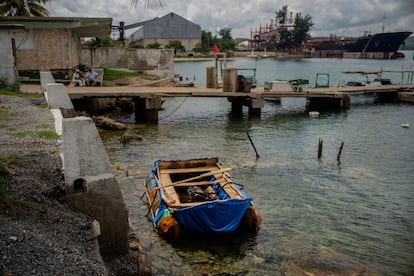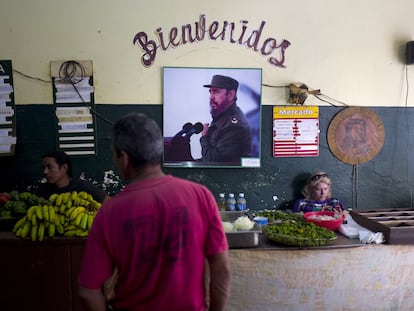At least 142 Cuban rafters have died this year trying to reach Miami
So far in 2024, the International Organization for Migration has recorded a total of 291 migrants dead or missing on Caribbean maritime routes

At 4 p.m. on August 21, Andrew Scharnweber, the head of the Miami sector of the U.S. Border Patrol, reported on X that several agents had approached 21 Cuban migrants that morning (three children and 18 adults) who had disembarked in the Florida Keys on a wooden fishing boat named “Habana.” This is the kind of news that Scharnweber has to announce quite frequently: a few days earlier he had said that 10 Cuban migrants (two minors and eight adults) were in custody after arriving on a homemade boat, and he also warned of a group of 33 Cubans who were awaiting processing for deportation to Cuba. These are the so-called rafters, who set out to travel one of the most dangerous migration routes from the island to reach the United States. This year alone, 142 Cubans have died trying to reach the U.S. in this way, according to the Missing Migrants Program of the International Organization for Migration (IOM).
In statements to EL PAÍS, Edwin Viales, regional monitor for the Americas of the Missing Migrants Project, warned of the risk involved in the sea crossing that Cubans undertake to reach Miami: “They use homemade boats that they build with materials available in their neighborhoods or homes,” he said. “These are obviously not designed for overseas crossings, which makes them even more vulnerable. In this specific case, the main risk is drowning, according to reports.”
Viales insisted that migrants who set out to sea can also be captured by groups dedicated to illegal migrant trafficking. In addition, “given the nature of their boats, they run the risk of going off course or being victims of what is known as an invisible shipwreck, which is a sinking event at sea that occurs without their families, civil or military authorities, the media or others knowing that this event has occurred,” he said.
Figures released by the IOM indicate that the situation in Caribbean waters has worsened: so far in 2024, the organization has recorded a total of 291 migrants dead or missing on Caribbean maritime routes, which represents an increase of almost 18% compared to the 247 documented in 2023. The 90-mile route separating Cuba from Miami is considered the most dangerous, followed by the one followed by migrants from the Dominican Republic to Puerto Rico, where 91 deaths have been recorded to date, in addition to one victim who was trying to reach the Dominican Republic from Haiti.
“The 291 lives lost by migrants during migratory transit in the Caribbean in these eight months is equivalent to an increase of 17.81% compared to the entire year 2023, and we have not even reached the month of December yet. Without a doubt, the outlook is not encouraging and, as the MMP has previously pointed out, what this tells us is that migration continues to be irregular and deadly, on many migratory routes in the Americas and around the world,” says Viales.
The sea, a cheap and dangerous escape route
Crossing the Florida Straits, though dangerous, has been one of the traditional routes used by Cubans to leave the country despite the fact that the administration of former President Barack Obama ended the Wet Foot/Dry Foot policy in 2017, which protected Cubans who touched U.S. territory. In the period from October 2020 to March 2023, the Coast Guard intercepted 12,866 Cubans at sea. Most of them were later deported back to the island.
Despite the deaths, the serious physical conditions, the dehydration after hours of sailing exposed to the sun and salt, and the risk of deportation, many continue to prefer this escape route, which is sometimes cheaper than the Central American route through Nicaragua, a journey that is still risky. An initiative by the Cuban media outlet El Toque recorded the deaths of at least 264 Cubans and 650 disappearances since 2014 on their journeys north. Of the deaths, only 98 people have been identified, most of them young, with shipwrecks and drowning being the main causes of death.
Edwin Viales told a public session of the IOM that “the outlook is not encouraging.” “Now more than ever, all the coordinated international efforts in the Caribbean are needed to save lives,” he said. Viales insisted that many of the boats used for these journeys disappear without a trace due to the dangerous natural conditions and the forced disappearances by the people smugglers. The U.S. authorities have also warned of these dangers and recommend using legal means to emigrate.
However, the widespread crisis in Cuba has uncovered the largest exodus in its history. The latest report from the Customs and Border Protection Office states that in July a total of 15,645 Cubans arrived in the United States, which represents an average of 504 arrivals per day. Of these, 4,918 arrived in Florida, mainly by sea. So far this year, almost 200,000 Cubans have arrived in the United States, and more than 600,000 have arrived since the migration crisis broke out, which researchers place in 2021.
Cuban economist and demographer Juan Carlos Albizu-Campos revealed in an independent study that the Cuban population is no longer 11 million people as official statistics say, but rather just over 8 million. In an interview with EL PAÍS, Albizu-Campos said that, as a result of this wave of migration, in Cuba “we are seeing the pattern of single grandparents with single children,” since 77% of the people who are emigrating are between 15 and 59 years old.
Sign up for our weekly newsletter to get more English-language news coverage from EL PAÍS USA Edition
Tu suscripción se está usando en otro dispositivo
¿Quieres añadir otro usuario a tu suscripción?
Si continúas leyendo en este dispositivo, no se podrá leer en el otro.
FlechaTu suscripción se está usando en otro dispositivo y solo puedes acceder a EL PAÍS desde un dispositivo a la vez.
Si quieres compartir tu cuenta, cambia tu suscripción a la modalidad Premium, así podrás añadir otro usuario. Cada uno accederá con su propia cuenta de email, lo que os permitirá personalizar vuestra experiencia en EL PAÍS.
¿Tienes una suscripción de empresa? Accede aquí para contratar más cuentas.
En el caso de no saber quién está usando tu cuenta, te recomendamos cambiar tu contraseña aquí.
Si decides continuar compartiendo tu cuenta, este mensaje se mostrará en tu dispositivo y en el de la otra persona que está usando tu cuenta de forma indefinida, afectando a tu experiencia de lectura. Puedes consultar aquí los términos y condiciones de la suscripción digital.
More information
Archived In
Últimas noticias
The metaverse, four years later: Is it finished or just at a standstill?
$3,000 and a plane ticket: The United States increases incentives for migrants to self-deport before the end of the year
Charles Dubouloz, mountaineering star, retires at 36 with a farewell tour inspired by Walter Bonatti
From the White House to diplomatic gifts: Lego wins over adult fans, brick by brick
Most viewed
- Families demand repatriation of bodies of Colombians who died in Ukraine: ‘This war is a slaughterhouse for foreigners’
- The low-cost creative revolution: How technology is making art accessible to everyone
- Liset Menéndez de la Prida, neuroscientist: ‘It’s not normal to constantly seek pleasure; it’s important to be bored, to be calm’
- Christian Louboutin: ‘Young people don’t want to be like their parents. And if their parents wear sneakers, they’re going to look for something else’
- Christmas loses its festive spirit: ICE fears cast shadow over religious celebrations











































